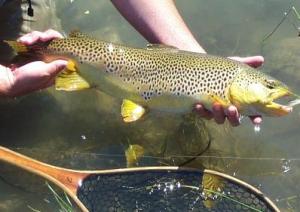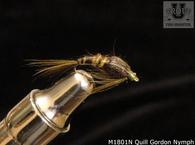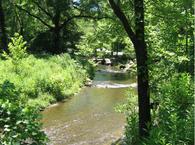A
Antron - A synthetic yarn material made of long sparkly fibers used for many aspects of fly tying including wrapped bodies, spent wings, and trailing shucks. Is also used for dubbing material.
Arbor – That component of the fly reel where the line is stored.
Aquatic Insect – An insect that spends some part of its life in the water.
Attractor Fly - A fly tied for the purpose of provoking a trout to strike.
B
Back Cast - The term used to describe the action of throwing the rod and the line backwards, allowing the line to unroll in the air before making a forward cast.
Backing Line – Inexpensive line attached to arbor of a reel. The fly line is attached to it with a nail knot. The Backing Line provides reserve line for long runs by the trout.
Bloodworm - Any of several red or red-blooded worms especially earthworms. Also can be the freshwater larva of midges.
Boil - A slight increase in the height of water on the surface indicating a trout is feeding just under the surface.
Barbless hooks - Hooks without the backward facing projection of a hook near the point.. Ideal for catch and release fishing.
Bead Head A Bead Head fly uses a metal bead to simulate the thorax on a nymph or wet fly and to add weight to the fly.
C
Caddis - Used to describe a large diverse family of aquatic insects characterized by down wings. Also the term for the sedge fly.
Caenis The scientific name for the broadwing fly, a tiny, pale green insect which hatches in large numbers on summer evenings besides rivers and lakes.
Cane Poles - This is a simple pole made from bamboo canes, and fished without a reel.
Camouflage - The act, means, or result of obscuring things to deceive an enemy, as by painting so that they are lost to view
Cheek - Feathers tied to the side of the hook, just behind the eye.
Chenille - A yarn or cord-like material commonly used for streamer bodies.
Chironomid Scientific name for the members of the Diptera family of insects commonly known as Midges. In the pupae stage they typically appear to be small aquatic worms.
Clinch Knot - A very basic knot used to tie hooks, lures, and tackle to the line. It has very good strength, is easy to tie, and is a good choice for the beginner.
Cripple - When a hatch occurs, quite a few pupa struggle and get tied up in their nymphal shucks. These cripples make easy pickings for trout, as Chironomid upon reaching the surface film often escape as duns into the air in a matter of seconds.
Count Down – This is a method to determining how down a lure or fly will travel, Once the rate of descent is known in feet per second, the angler can determine the dept by counting the seconds.
Covert - A small non-flight related bird feather.
D
Damselflies - An insect in the Order Odonata. Damselflies are similar to dragonflies, but the adults can be differentiated by the fact that the wings of most damselflies are held along, and parallel to, the body when at rest
Dead drift - A fly fishing technique in which the fly (dry or wet) is allowed to drift freely along in the current.
Double Tapered Fly Line - This is fly line that is narrower (smaller diameter) at the head and tail of the line than in the middle. The taper usually gets bigger after the first 15 feet, then has 60 ft of the wider diameter and ends with 15 ft of taper again.
Dragonflies - Any of numerous stout-bodied, nonstinging insects of the order Odonata (suborder Anisoptera), the species of which prey on mosquitoes and other insects and are distinguished from the damselflies by having the wings outstretched rather than folded when at rest..
Drag
Refers to the wake made by the fly when being retrieved or when the fly has reached its maximum drift on a stream.
Dropper- A short length of leader connected to the main leader with a fly attached..
Dry Flies - Usually imitate terrestrial insects (i.e. insects that live on land, such asants, bees, grasshoppers, etc.) or the adult versions of aquatic insects that have risen to the surface to fly away. They are allowed tofloat on the surface with the current as you fish them.
Dubbing - A primary body ingredient in both dry flies and nymphs, dubbing is a chopped-up fibrous material pinched and twisted onto the thread for wrapping onto the fly. Also refers to the process of applying the dubbing material.
Dun - Term used to describe an adult aquatic insect following emergence from the water
E
Emerger - An aquatic insect in the process of rising to the surface and changing to a flying adult form. Often will have an attached trailing shuck which feeding fish may key upon.
F
Federation of Fly Fishers - A non-profit organization dedicated to teaching the sport of fly fishing and the improvement of fisheries.
Fingerling A small, immature fish.
Fly line: - A weighted line which is cast out onto the water to deliver the fly to the desired location. The weight of the line is what drives the fly. Can be found in many densities and tapers.
It can either be floating (this is the most common, and can often be used for all types of flies in shallow streams), or sinking (this would be used primarily for nymphs and streamers in deep streams). Additionally, the taper of the fly line determines how far/gently it casts.
The fly reel:- The reel, used with the fly rod, is relatively simple, in that it simply holds the line while not being used. (I.e. There is no casting feature required.) The line is pulled out by hand as it is needed for longer casts.
Fly Rod - The type of fishing rod used to cast the flyline to the desired position. Historically built with bamboo canes and fiberglass, but now almost exclusively with carbon graphite.
Fly Tying The process of building fishing flies using thread and various materials.
Floatant - Material applied to flies and leaders in order to cause them to float on the surface of the water.
Freestone creeks originate in the higher elevations and are formed by precipitation including snow, rain and dew. They are acidic in nature and usually do not support a large population of trout. Water flow and water temperature vary greatly due to rains and snowfalls
H
Hackle - Any soft-stemmed neck feather with non-adhering barbules. Typically used to refer to hen or rooster chicken feathers. Tied to represent the legs of an insect.
Hatch - The time when a large number of nymphs or pupas become fully winged flies, often producing frantic feeding activity among trout
.
Hen Hackle - Hackle feathers from a hen chicken characterized by soft, wide feathers. Since these feathers readily soak up water, they are usually used on nymphs and streamers.
Hellgrammites – These are the larva of the Dobson Fly which is similar to a Dragon Fly. They can be found under rocks in fast moving water.
Herl
Single strands taken from any large feather, commonly Peacock.
I
In-line spinners - These artificial lures are often made by hooking a blade around a line of wire that connects the hook to the line. They are used to mimick the sounds and vibrations of a wounded bait fish.
J
Jig - A small artificial lure with a metal head, often dressed with feathers.
Jigging - Fishing by jerking a jig or other bait up and down in the water; an ice-fishing technique
K
Krystal Flash
Highly reflective material tied to all types of flies.
L
Lace - Hollow fine plastic tubing wrapped around a hook shank to supply a segmented body.
Larva - Sub surface stage of development of an aquatic insect.
Leader - Section of line used between the flyline and the tippet. Often purchased as a tapered section, but can be assembled by tying successively smaller diameter sections of monofilament.
Line Tray - A tackle tray used to collect the coils of backing or fly line, stopping them from falling to the ground Normally attached to the fisherman around the waist.
Livebait - Any natural bait, such as a worm, maggot, or small fish, that is used live.
Loop Connection - A method of setting up a flyline/leader rig using loops tied in each section which can be interlocked for easy changing.
Leeches - Any of various chiefly aquatic bloodsucking or carnivorous annelid worms of the class Hirudinea.
M
Marabou - Turkey feather fibers used extensively as wings and tails of lures/streamers
Mayfly - Term used to describe a common aquatic insect which has a life cycle containing four stages; pupae, larva, dun and spinner. Many, if not most fly patterns are used to imitate this type of insect in its various stages of development
Match-the-Hatch - Observe and match the color of the abdomen.
Mend - Throwing the line upstream or downstream after the fly hits the water to eliminate drag
Midge - Technically a specific form of aquatic insect life, but frequently used to describe a particular tying style, usually a small fly with a floss body.
Mylar - Metallic plastic available in sheet or plaited tube form. The tubing can be used to simulate scales on the flanks or fry imitating lures/streamer flies.
N
Nail Knot - A knot used to tie together two lines of significantly different diameters.
Nymph - The developmental stage of aquatic insect life or used to describe a style of fly which has little in the way of wings or tail.
P
Palmer - A method for wrapping a hackle feather over a section of the fly's body. When it is retrieved through the water it 'pushes' the water and this causes attractive movement shock waves that help fish locate the fly
Parachute fly - A dry fly with its hackle wound in the horizontal plane to help it float on the surface of the water and land softly so as not to spook the fish.
Pupa - Sub-surface larval stage of aquatic insect development. The wings and gills have developed and they become tasty treats for trout as they ascend to the surface.
Plugs - They are lures made to resemble bait fish, and or terrestrials, and they are very effective, especially on the larger streams or pools.
Q
Quill - The individual sections that make up a feather usually the spine of the feather.
R
Roll Cast - The method of casting a fly from the side, when there is no room behind you for a back cast.
S
Scuds - The term used for freshwater shrimp.
Sculpin - A bottom feeding fish that is small and not considered good to eat. They have sharp spines rather than scales. Sculpin can live for several hours out of water if kept moist.
Soft Hackle - Used for wet flies since the softer fibers are not useful for creating buoyancy.
Soft plastic imitations - These lures are made are made of soft material and are made to imitate natural food such as minnows, crafish, etc.
Spinner - A spent adult aquatic insect following laying its eggs on the surface of the water
Spoons – A curved blad attached to a hook and meant to resemble a wounder fish. A favorite among fishermen for many years.
Spring creeks are formed by spring water as it leaves the underground
aquifers. This water is more alkaline and capable of supporting the aquatic insects that form most of the trout’s diet. As a result, the trout populations tend to be greater. Water flow and temperatures are not as affected by the rain and snowfalls.
Stimulator- Used frequently with a dropper, it is a dry fly that doesn't closely mimic one particular insect, but is generic.
Stonefly - Family of aquatic insects commonly imitated in flyfishing. Many species are found in western streams.
Strip - The term used to describe taking in the line by hand, as opposed to reeling it in.
Stripping Basket – A basket used to hold the fly line both for the cast and for the retrieve.
Streamer – A fly that is fished subsurface and mimics a small fish or fry.
Stripping Basket This is a basket usually tied to a fly fisherman’s waist and it is used to collect the line as it is stripped.
Spun Deer Hair - Hollow hair which when tied firmly to the hook stands erect and is buoyant.
Surface Film - The apparent elastic like film on the surface of water, which is created by surface tension.
T
Tandom Fly - A fly consisting of two or more in line hooks connected by a short length of strong line.
Taper - The narrowing in diameter, from butt to tip, of a rod, and the narrowing of the end section of a fly line. The rate of taper determines the action of the rod or line.
Tailwater - The water that outflows from large dams. It comes from the bottom of the
reservoir where the water remains at a cooler and constant temperature. This cooler silt free water provides ideal conditions for trout to thrive.
Terrestrial – As it applies to trout fishermen, it simply means “growing on land, not aquatic”. Therefore any flies to imitate them would be dry flies meant to imitate insects on land such as a grasshopper, or ant, etc..
Tippet- The thin end section of a fly leader, to which the fly is tied.
Triploid trout - Triploid trout are created with a third set of chromosomes which rendere them sterile. Normally, the third set of chromosomes is kicked out after fertilization, but a heating process after fertilization will cause them to remain; viola the triploid!
U
Undercurrent - The flow of water beneath the surface which can be opposite the surface flow on still waters.
Upstream - Against the current of the river or stream.
W
Wet Flies – A fly that imitates an aquatic insect that is under the surface of the water, rising to the top to fly away.
Weighted Flies - A weighted fly is wrapped with lead wire or a metal bead or even a heavy, stout hook.
Wingcase - The use of materials to simulate the unformed wings of emerging aquatic life
.






